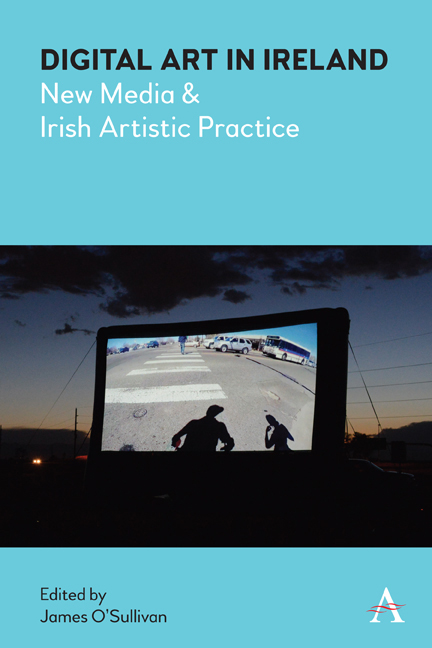Book contents
- Frontmatter
- Dedication
- Contents
- List of Illustrations
- Acknowledgements
- Notes on Contributors
- Chapter 1 Introduction: Digital Art in Ireland
- Chapter 2 Strange Mothers: The Maternal and Contemporary Media Art in Ireland
- Chapter 3 Between Aesthetics and Institutions: Irish Electronic Poetry
- Chapter 4 ‘to shine upon the original all the more fully’: Contemporary New Media Adaptations of James Joyce
- Chapter 5 Art in the Data-City: Critical Data Art in the Age of Surveillance Capitalism
- Chapter 6 Experimental Arcade Video Games as Self-Reflexive Media Art
- Chapter 7 Folding, Unfolding, Refolding Sound Claire Fitch
- Chapter 8 Treacherous Images and Animal Gazes: Ailbhe Ní Bhriain's Reports to an Academy, 2015
- Chapter 9 Pressing Send: Distribution and Curation in Irish New Media Art
- Index
Chapter 6 - Experimental Arcade Video Games as Self-Reflexive Media Art
Published online by Cambridge University Press: 23 February 2022
- Frontmatter
- Dedication
- Contents
- List of Illustrations
- Acknowledgements
- Notes on Contributors
- Chapter 1 Introduction: Digital Art in Ireland
- Chapter 2 Strange Mothers: The Maternal and Contemporary Media Art in Ireland
- Chapter 3 Between Aesthetics and Institutions: Irish Electronic Poetry
- Chapter 4 ‘to shine upon the original all the more fully’: Contemporary New Media Adaptations of James Joyce
- Chapter 5 Art in the Data-City: Critical Data Art in the Age of Surveillance Capitalism
- Chapter 6 Experimental Arcade Video Games as Self-Reflexive Media Art
- Chapter 7 Folding, Unfolding, Refolding Sound Claire Fitch
- Chapter 8 Treacherous Images and Animal Gazes: Ailbhe Ní Bhriain's Reports to an Academy, 2015
- Chapter 9 Pressing Send: Distribution and Curation in Irish New Media Art
- Index
Summary
This chapter provides an insight into the rationale and creative process behind two game-based artworks from the point of view of their creator. Both are self-reflexive artefacts, meta games that use the material of the arcade video game interface to experientially articulate and explore issues surrounding its materiality, aesthetics and connective qualities. The interface in this case is not just the control and feedback mechanisms of the game input device and the audiovisual feedback, extending to all communicative links of the system, but also as defined by user context and the situated environment of the video game platform.
Control (2013) articulates the resolution divide between the digital and physical worlds, going against the commercially driven ideal of having a user interface that is so intuitive that it is seamless to the point of becoming practically invisible. Instead, Control places all focus on the manual hand-to-controller link as the subject of the gameplay experience. Simultaneously it provides a timeline of game controller evolution and complexity, alongside a meta commentary on accessibility in gaming.
Arcade Operator (2017) is the sequel to Control, and explores the interface as defined by user context. It transposes the gameplay and interface mechanic of sideways scrolling arcade brawlers of the 1980s and 1990s onto the nongameplay mode of repairing arcade platforms, albeit through the diegetic space of the arcade gamefield. In doing so it also seeks to demystify the closed black box systems of arcade hardware platforms.
As digital creative platforms constantly evolve and push the envelopes of resolution and high fidelity, this body of work embraces the challenge of working within the aesthetic constraints faced by game designers in the mid-1980s to late 1990s. These self-imposed limitations in terms of colour palettes, game audio and interaction control schemes proved an essential part of the artist's journey into tacitly understanding and creatively interfacing with the material nature of arcade gaming as both a medium and a genre.
Modes of Interfacing
When playing an arcade video game, the participant at play is immersed in both the diegetic spaces created within the audiovisual, and often haptic, feedback space of the arcade machine, and also surrounded by a peripheral sensory layer of stimulus from the situated environment in which the arcade machine is located.
- Type
- Chapter
- Information
- Digital Art in IrelandNew Media and Irish Artistic Practice, pp. 91 - 104Publisher: Anthem PressPrint publication year: 2021



